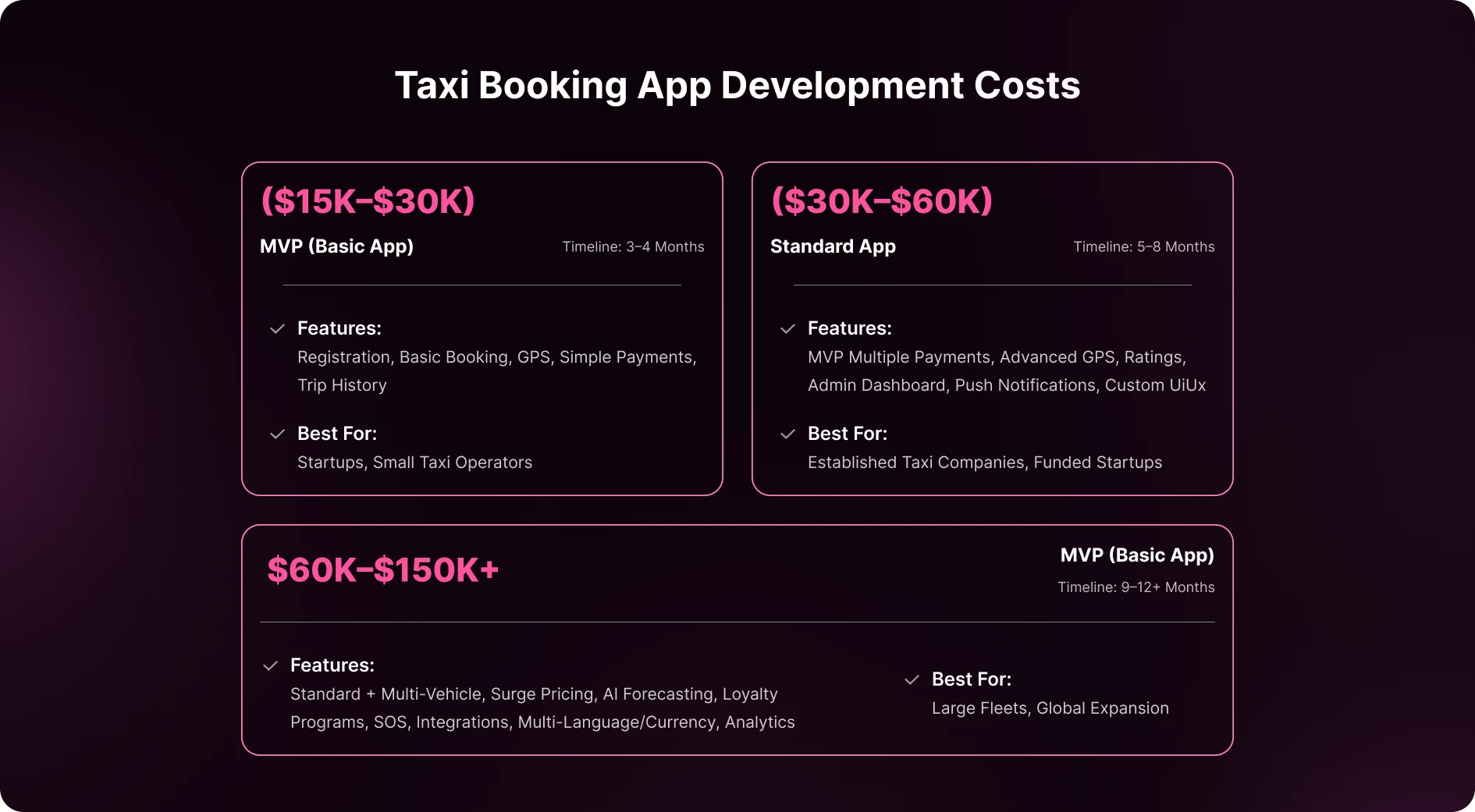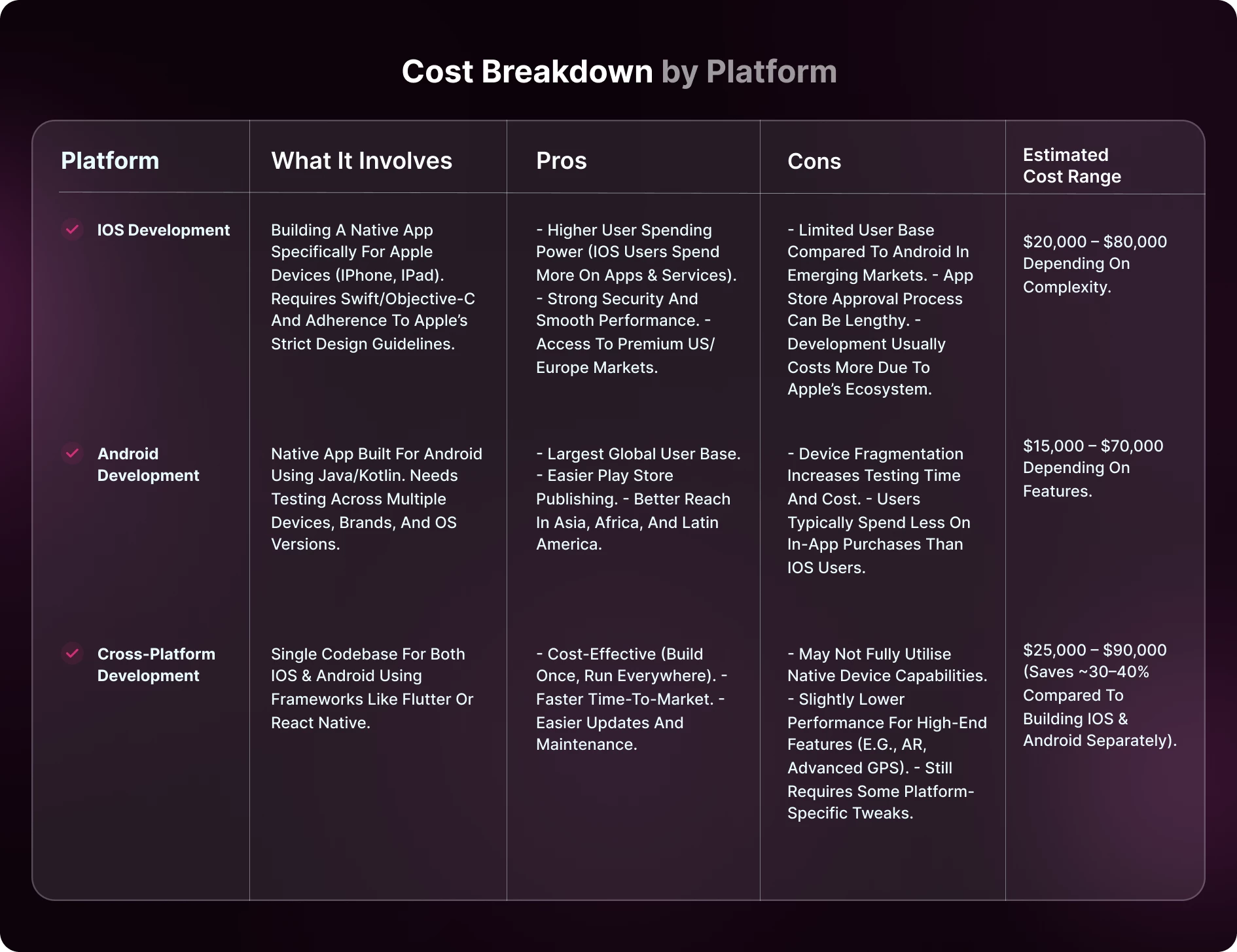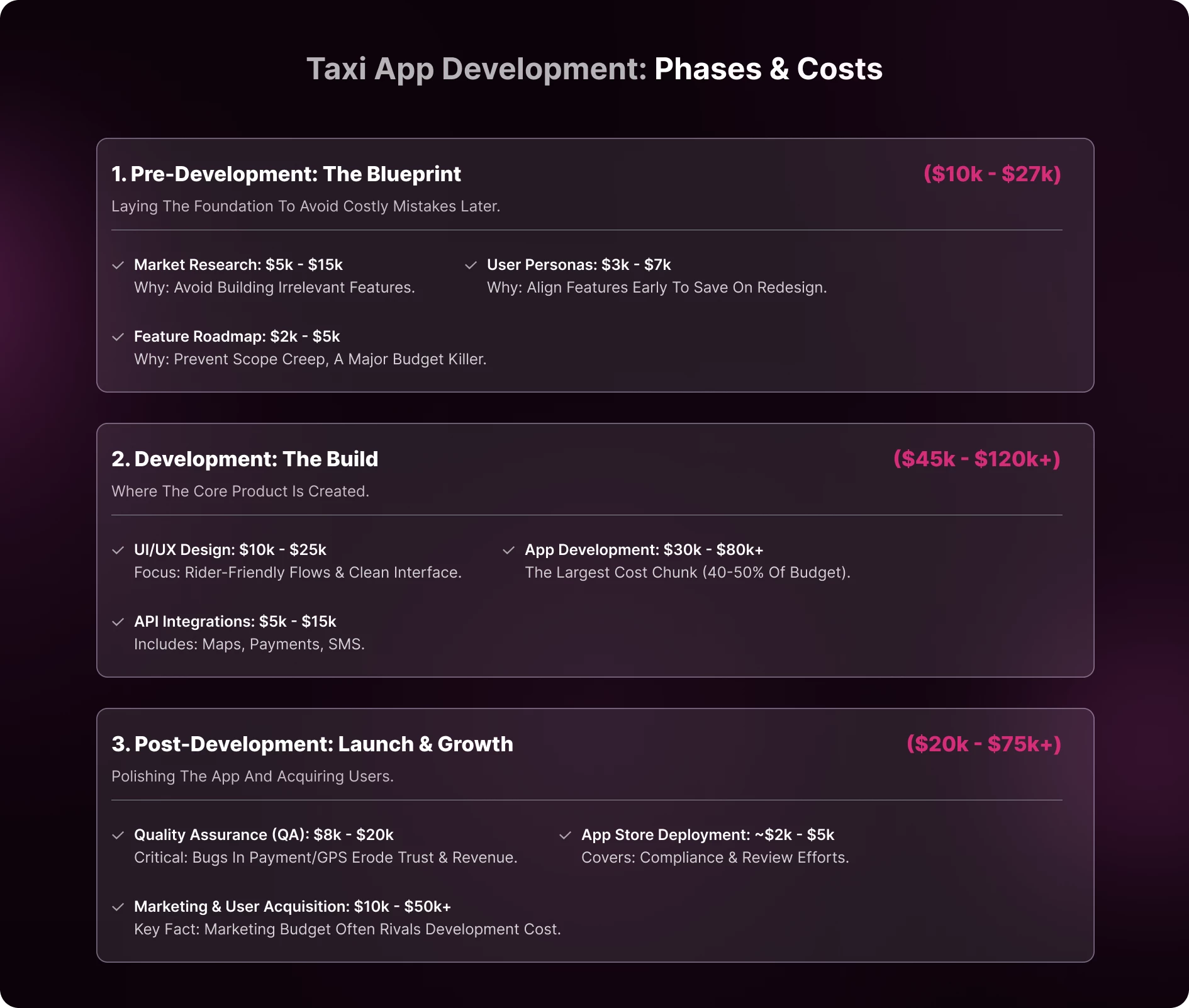31 January 2025
How to Choose the Best Mobile App Development Company for Your Business Read MoreImagine a world without ride-hailing apps. No Uber to book on a rainy night, no Lyft to rely on when your car won’t start, no local Ola or Bolt for that quick airport drop. Hard to picture, right? That’s because these apps have become more than just a convenience; they’re a daily necessity for millions of people worldwide.
The ride-hailing industry is booming, with the global market projected to cross USD 432.63 billion by 2028. Giants like Uber and Lyft dominate in North America, while Ola, Grab, and Bolt lead in Asia and Europe. But here’s the catch: despite these established players, the market is still wide open for startups and traditional taxi businesses ready to go digital.
And that brings us to the big question: how much does it actually cost to build a taxi booking app? Understanding taxi booking app development cost isn’t just about writing a cheque to a tech team. It’s about smart budgeting, future-proof planning, and ensuring that every dollar invested brings you closer to competing with the big names. Whether you’re a small taxi operator or a funded startup, knowing the cost to develop taxi booking app dynamics can make the difference between a profitable app and an expensive experiment.

Before we get into understanding how much does it cost to develop a taxi app, let’s understand it’s components. When you think about a taxi app, it’s easy to imagine it as just a screen where you tap “Book Ride” and a car magically appears. But in reality, these apps are like a three-legged stool, each leg (the passenger app, driver app, and admin panel) holds up the entire experience. If even one leg is weak, the whole thing wobbles. Let’s break it down.
For passengers, the app is their travel companion. It starts with user registration and profile management, simple sign-ups via email, phone, or social media so that hopping into a cab is just a few clicks away. Once set up, the heart of the app lies in ride booking and scheduling. Imagine needing an early morning airport ride, being able to schedule it the night before brings peace of mind.
Of course, no one likes surprises when it comes to money. That’s why fare estimation and payment integration is critical. A clear fare estimate and multiple payment options (credit card, wallet, UPI, etc.) build trust instantly. Add to that real-time ride tracking and history, and passengers know exactly where their driver is and can revisit past trips with ease. Finally, ratings and reviews empower users to share feedback, keeping service quality in check.
Now, flip the perspective. For drivers, the app is their daily toolkit. It starts with driver registration and verification, ensuring only vetted professionals get behind the wheel. Once approved, drivers need to seamlessly accept rides and navigate, with integrated maps guiding them through the fastest routes.
The app also doubles as an accountant. With earnings tracking and payment features, drivers know exactly how much they’ve made that day or week, without waiting for manual reconciliations. Just like passengers, drivers too get to share ratings and feedback, creating a transparent two-way system where both sides are accountable.
Behind the scenes is the admin panel, the brain of the operation. This is where the business owner or operator keeps the entire system running smoothly. From user and driver management (approving new drivers, resolving disputes) to trip monitoring and analytics (understanding peak hours, average ride times), the admin dashboard provides real control.
But it’s not just about oversight, it’s also about money. With financial reporting and settlements, admins can track revenues, driver commissions, and payouts with accuracy. And to keep riders coming back, features like promotions and notifications allow admins to roll out offers or send timely updates directly to users’ phones.

If there’s one question every founder, investor, or taxi business owner asks before building a ride-hailing app, it’s this: “How much does it cost to develop a taxi app?”
Unfortunately, there’s no one-size-fits-all answer. Think of app development like building a house. You could build a cosy two-bedroom home, a comfortable duplex, or a luxury mansion. All three will give you a roof over your head, but the design, materials, and finishing will decide the price tag. Taxi app development works the same way, your vision, feature set, and scale will shape how much you need to invest.
To make sense of it all, let’s break down the cost to develop taxi booking app into three tiers, MVP, Standard, and Enterprise-level apps, and then look at how costs differ across regions and business types.
An MVP (Minimum Viable Product) is like the “starter pack” for taxi apps. It’s the lean version that includes just enough features to test your idea in the market. Think of it as putting your toe in the water before diving headfirst.
MVPs are popular with startups that want to validate an idea quickly without blowing their budget. For example, imagine a small local taxi operator in a city like Austin or Bangalore. Instead of competing head-on with Uber from day one, they launch a basic app to digitise bookings and see how users respond.
If riders find value, they can reinvest in scaling features like carpooling, loyalty programs, or AI-driven route optimisation. The key is speed and affordability, you spend just enough to learn and pivot if needed.
Once you’ve tested the waters and know your idea has legs, it’s time to level up. A Standard Taxi App is more polished, user-friendly, and packed with additional features that make it competitive in a crowded market.
This is the stage where your app goes from being “just functional” to “delightful to use.” It’s like upgrading from a basic hatchback to a mid-range SUV, still practical, but with comfort and style that people notice.
For instance, when Ola started expanding beyond India’s tier-1 cities, they moved from a basic booking app to a full-fledged platform with flexible payment options and better UI, targeting urban users with higher expectations.
This is the “dream home” version. An Enterprise-level taxi app is what you’d expect from global giants like Uber, Lyft, or Grab. It’s designed to handle massive scale, complex integrations, and advanced technologies.
This is not just an app, it’s a digital ecosystem. Every part of the business, from operations to marketing, is powered by data and technology.
For example, Bolt (formerly Taxify) didn’t just copy Uber; they invested heavily in enterprise-level features tailored to the European market, such as lower commission models for drivers and integrations with local payment systems. That level of sophistication costs big money, but it also brings big returns.
One of the biggest factors that decides your taxi app development cost is where your developers are located. The same app could cost $30,000 in one country and $120,000 in another. It’s not about quality alone, it’s about living costs, hourly rates, and market dynamics.
Bottom line? If you’re a startup with a limited budget, Asia or Eastern Europe often gives the best value for money. But if compliance, security, and long-term partnership are top priorities, North America or Western Europe might be worth the extra taxi app development cost.
To put this into perspective, let’s look at how different businesses allocate budgets.
A two-person team in Nairobi wanted to launch a taxi-hailing app focused on safe rides for women. With limited funds, they chose an MVP costing around $20,000 developed by an Indian team. They launched quickly, tested demand, and attracted angel investors. With fresh funding, they expanded to add emergency SOS buttons and women-only driver options.
A mid-sized taxi fleet in Madrid needed to go digital to compete with Uber. They invested $50,000 into a standard app with real-time tracking, multiple payments, and promo codes. Within a year, they doubled their ridership, as customers preferred their familiar brand with modern features.
A Southeast Asian startup, backed by millions in funding, aimed to be the “Uber of logistics and mobility.” They invested $200,000+ into an enterprise-level app built in partnership with a European development company. The app supported taxis, bikes, and deliveries, all in one platform. The upfront cost of taxi app development cost were huge, but their scalability meant they could dominate across five countries.
| Factor | What It Covers | Estimated Cost Range |
|---|---|---|
| Feature Complexity | GPS tracking, in-app chat/call, multiple payments, admin dashboard | $20,000 – $60,000 |
| Design & UX | Custom UI/UX, branding, theming, user testing | $10,000 – $30,000 |
| Technology Stack | Backend (Node.js/Rails), frontend (React Native/Flutter), database, cloud | $25,000 – $60,000 |
| Team Location | North America: $80K–$200K+, Eastern Europe: $40K–$90K, India: $20K–$60K | Varies widely |
When it comes to taxi app development, there’s no flat fee. The final bill depends on what you put inside the app, how it looks, the technology running it, and even where your developers are based. Let’s break down the main cost of taxi app development cost drivers with realistic ranges.
Every feature adds hours of coding, testing, and refining. The more complex they are, the higher the bill.
In total, feature complexity can push development anywhere from $20,000 to $60,000, depending on scope.
Good design is not just about looks, it’s about making the app feel effortless. A confusing taxi app will be deleted after the first ride.
A polished design usually ranges from $10,000 to $30,000.
Your tech choices are like deciding between a sturdy hatchback or a luxury SUV. Both get you moving, but with different performance and cost of taxi app development cost.
Technology stack decisions typically total $25,000 – $60,000.
Who builds your app, and where they’re based, changes the budget dramatically.
Many startups prefer hybrid models: strategy handled locally, development outsourced to save development cost of a taxi booking app. Managing costs while building a feature-rich taxi app requires experience, planning, and technical expertise. DevStory combines all three. Our team provides transparent cost to develop taxi booking app estimates, guides you through feature prioritization, and leverages the best technology stacks to deliver high-quality apps efficiently.

Pro Tip: Many startups begin with cross-platform development to save costs and launch quickly. Later, when user demand grows, they often invest in native iOS and Android versions for maximum performance.
When it comes to taxi app development, the feature set is where your budget really takes shape. Think of it like buying a car. The base model gets you from A to B, but add-ons like leather seats, sunroof, or advanced navigation quickly raise the price. Taxi apps follow the same logic: core features are must-haves, advanced features create differentiation, and optional features offer nice-to-have perks. Let’s break it down.
Core features are the backbone of every taxi app. Without them, the app simply can’t function.
Together, core features usually range from $20,000 to $40,000 depending on complexity.
Once the basics are covered, advanced features make your app stand out in a crowded market.
Expect advanced features to add another $20,000 – $45,000 to on demand taxi app development cost.
These aren’t essential for launch but can elevate user experience if your budget allows.
Optional features typically cost $15,000 – $35,000 in total.
Building a taxi app isn’t just about getting passengers from point A to point B, it’s also about ensuring your business model fuels long-term revenue. Choosing the right monetization strategy is as important as the features you build, because it influences both how much the app costs to develop and how it will sustain itself after launch. Let’s look at the most common models and their impact on development.
This is the most widely used model, apps like Uber, Lyft, and Ola thrive on it. The app charges drivers a percentage of each completed ride, typically ranging from 15% to 30%.
Impact on Development Costs: To support this model, you’ll need features like automated commission calculation, secure driver wallets, and real-time ride tracking for transparency. Adding these can raise development costs by $10,000 – $20,000 depending on complexity.
Instead of commissions, some platforms charge a fixed subscription fee to drivers or passengers. For example, drivers might pay a monthly fee for unlimited access to ride requests, or passengers could unlock perks (like priority booking) through premium subscriptions.
Impact on Development Costs: This model requires subscription management systems, recurring billing integrations, and tier-based feature access. Building these adds around $8,000 – $15,000 to development cost of a taxi booking app.
Freemium is a hybrid approach. The app offers basic usage for free, but charges for extra features. For instance, passengers could pay for premium features like choosing a favourite driver, booking luxury cars, or zero-surge pricing.
Impact on Development Costs: Supporting freemium means building feature gating, in-app purchase systems, and dynamic upgrades. This can add $7,000 – $12,000 depending on how many premium features you introduce.
Some apps generate revenue by showing ads, either through third-party networks (like Google AdMob) or brand partnerships. For example, local restaurants could advertise rides to their outlets, or car insurance firms could target drivers.
Impact on Development Costs: Integrating advertising SDKs is relatively inexpensive ($3,000 – $7,000), but if you’re building a custom ad management system, costs rise further.
Your monetization choice doesn’t just affect revenue, it impacts your initial development costs and long-term scalability.
Smart founders often combine models, for example, commission + ads, or subscription + freemium, to diversify revenue streams.
Taxi apps are no longer just about booking rides, they’re evolving into smart mobility platforms. Artificial intelligence (AI) and emerging technologies like blockchain, IoT, and 5G are reshaping how these apps function. While they open up exciting possibilities, they also add new layers of cost of taxi booking app development cost and complexity.
AI is already powering some of the most popular ride-hailing platforms.
Beyond AI, other innovations are also shaping the ride-hailing space.
Ready to future-proof your taxi app with AI and emerging technologies? Partner with DevStory to integrate smart features like dynamic pricing, predictive analytics, chatbots, blockchain, and IoT, while keeping the taxi booking app development cost efficient and timelines on track.

Building a taxi booking app is not just about writing code. Each stage of the process adds layers of time, expertise, and investment. Understanding how development phases map to cost helps businesses plan realistically and avoid surprises.
Before a single line of code is written, groundwork shapes both cost of taxi booking app development cost and direction.
This is where the bulk of the budget is spent.
Once coding ends, polishing and scaling begin.
Building a taxi booking app is a long-term investment. The right development partner doesn’t just deliver code, they help you shape a scalable product, control cost to create taxi app, and support you beyond launch. This choice directly affects both your budget and your app’s success.
At DevStory, we bring deep expertise in taxi booking app development, backed by a portfolio of successful projects across industries. Our approach is transparent, from cost to create taxi app estimates to delivery timelines, ensuring there are no hidden surprises. Clients value our mix of technical depth and business understanding, which helps them scale faster while keeping budgets in check.
With structured processes, proven frameworks, and dedicated post-launch support, DevStory is not just a vendor but a long-term partner. Whether you’re building an MVP or scaling a full-fledged app, our team ensures you get both quality and cost to develop taxi app efficiency.
A great taxi booking app wins on reliability and ease of use, not just functionality. To achieve this without blowing your budget, you need a strategic approach to taxi app development services. This starts with a clear understanding of the necessary modules for passengers, drivers, and admins, and a realistic, region-specific breakdown of the development costs. This level of planning is your best defense against overspending.
While your choice of features, design, and development team location directly impacts your budget, don’t overlook the power of new technology. The right development partner will use AI, IoT, and 5G to elevate your app’s performance, proving that smart investment is just as important as cost control.
The takeaway? Treat your taxi app as a long-term investment, not a one-off project. The businesses that succeed are the ones that budget wisely, innovate continuously, and partner with the right development team.
That’s where DevStory comes in. With proven expertise in taxi app development, cost to develop taxi app transparency, and end-to-end support, we help businesses turn ideas into scalable, revenue-driving apps.
Ready to build your taxi app the smart way? Let DevStory be your trusted development partner. Get in touch today.